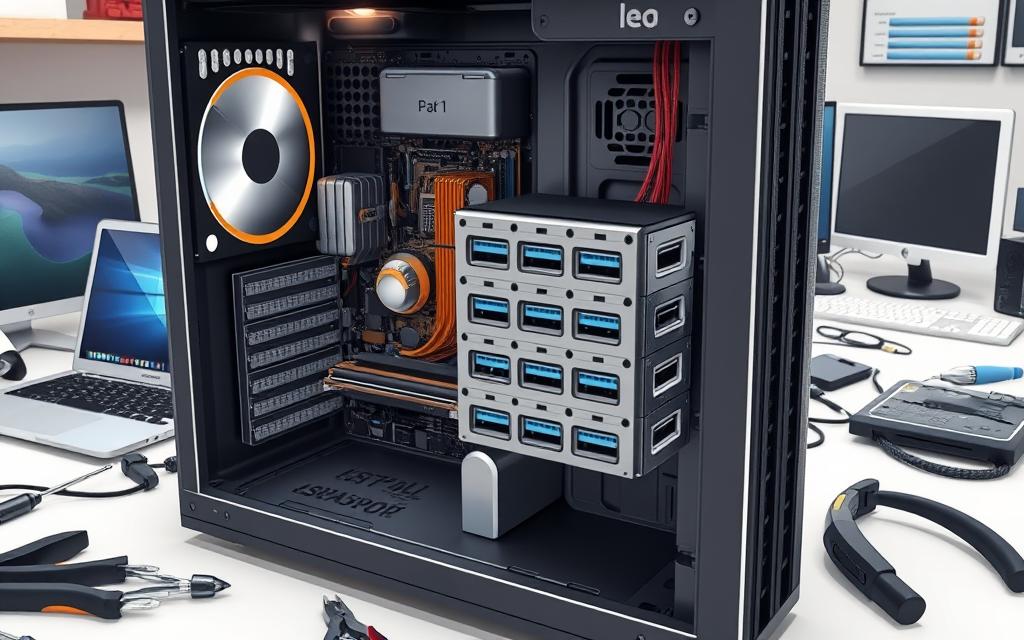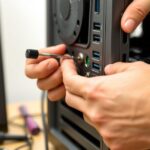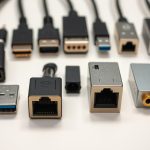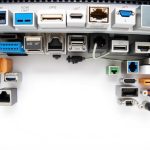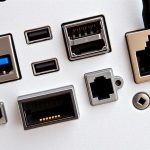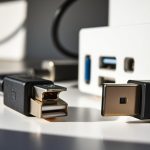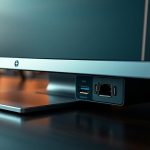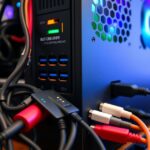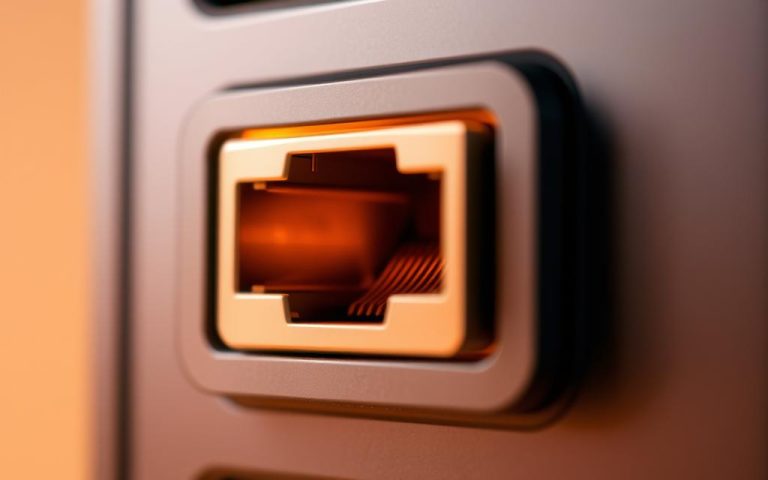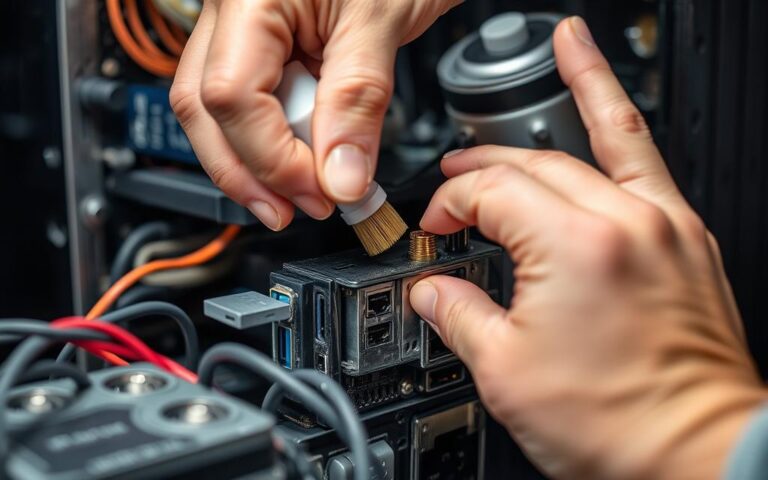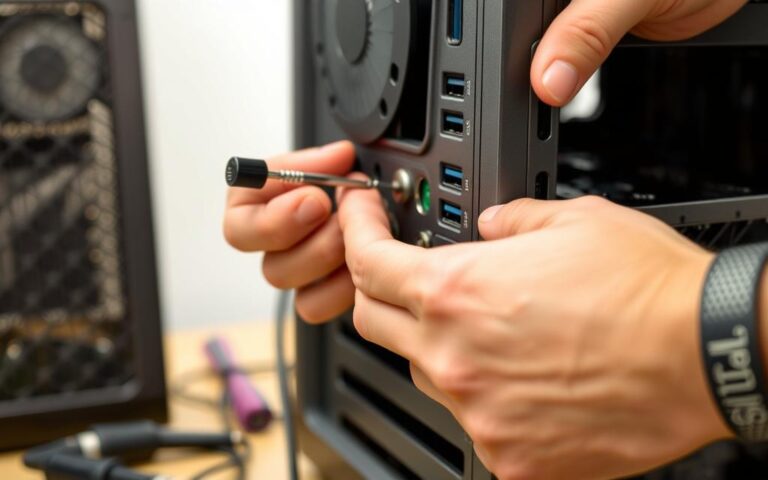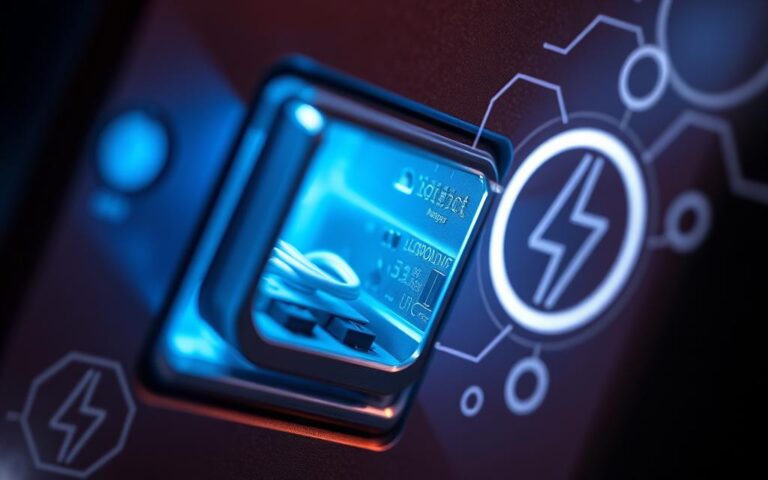Guide to Adding More USB Ports to Your Computer
In our digital age, everyone needs more ways to connect. Many laptops have just one or two USB ports. This makes it hard for us to connect all our devices at once. Whether it’s for work, play, or everyday tasks, having more USB ports is vital.
We’ve created this guide to help you add more USB connectivity to your computer. It covers everything from simple USB hubs, which add 3-4 ports, to advanced PCI-E cards that offer up to seven extra ports. There are many solutions to expand your computer’s USB capacity.
As more gadgets switch to USB-C, it’s crucial to know how to increase your USB port count. This guide will explore different ways to boost your ports and connectivity. Join us as we look into enhancing your USB possibilities.
Why Adding More USB Ports is Essential
Today’s world demands more connections than ever. With various USB devices like keyboards and webcams, we quickly run out of ports. This makes adding more USB ports crucial for efficiency. With each device needing a USB spot, the need grows daily.
The Need for Connectivity
Being able to plug in many USB devices at once is crucial. Often, people switch devices because they don’t have enough ports, which disrupts work. Adding more ports is not just about work; it improves gaming and creative tasks too.
Devices that Require USB Ports
USB technology keeps evolving, leading to more gadgets that need USB ports. Devices needing these ports include:
- Keyboards and mice for input
- Webcams for video conferencing
- Printers for hard copy outputs
- External hard drives for storage
- Game controllers for gaming setups
Using powered USB hubs helps charge gadgets even when the computer is off. These hubs can have extra features like card readers and LED lights. Docking stations also offer a great way to easily connect everything you need.
If you’re thinking about adding more USB ports, there are many ways to do it. For more information, check out this guide on adding USB 3.0 ports.
How to Add More USB Ports to Your Computer
Adding more USB ports boosts your computer’s usefulness. You can choose from a few easy to complex options. Picking the right one depends on what you need and prefer.
Overview of Expansion Options
There are different ways to add USB ports to your computer.
- USB Hub: A USB hub is a simple choice for more ports. You can plug in up to four devices at once with a 4-port hub. It comes in types like USB 2.0 and USB 3.2, offering different speeds.
- Expansion Card: Installing an expansion card gives you extra USB ports. It’s great for fast data transfers.
- USB Port Extenders: With port extenders, you can use USB devices far from your computer. It brings the ports to you.
Choosing the Right Method for Your Needs
What you need from a USB expansion shapes your choice. Think about:
- Frequency of Use: A USB hub is fine for casual use. But, an expansion card might be better for using lots of devices often.
- Device Power Requirements: If you’re charging devices, get a hub or card that can handle it. Some hubs have special charging ports.
- Compatibility: Check that your choice works with your computer. Most USB hubs are okay with Windows and Linux®.
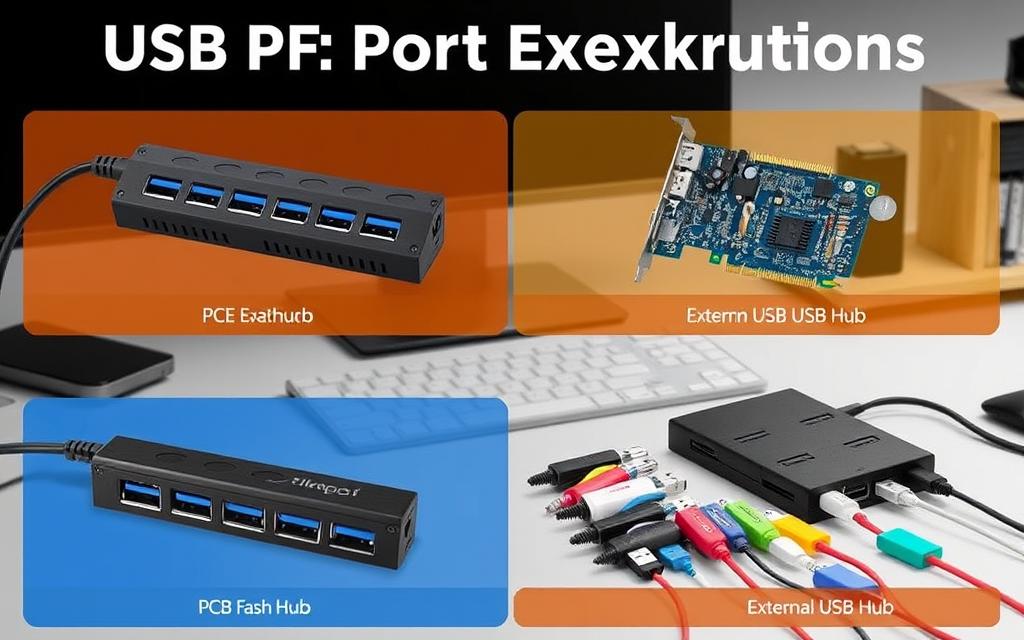
Knowing your options makes picking one easier. Focus on what you need and check compatibility for a smooth digital setup.
| Method | Port Count | Typical Speed | Power Delivery |
|---|---|---|---|
| USB Hub | 4 to 10+ | Up to 480 Mbps (USB 2.0)/10 Gbps (USB 3.1) | Depends on hub type |
| Expansion Card | Varies | Up to 10 Gbps (USB 3.1) | High power support |
| USB Port Extender | Varies | Depends on connection type | May drain battery faster |
Using a USB Hub for Quick Expansion
If you need more USB ports, a USB hub is a great fix. Understanding the types and how to pick the best one can boost your connectivity.
Types of USB Hubs Available
There are several kinds of USB hubs designed for different needs:
- Standard USB Hubs – They have multiple ports and connect to a computer via USB. This makes them simple to use.
- Powered USB Hubs – These get power from an outside source. It’s perfect for energy-hungry devices like external hard drives.
- Bus-Powered Hubs – They use the computer’s power, making them portable. Best for less demanding devices.
Considerations for Selecting a USB Hub
When choosing a USB hub, think about these hub selection criteria:
- Number of Ports: Make sure the hub has enough ports for your devices. Most hubs offer up to seven ports.
- USB Version: Choosing USB 3.0 is smart because it’s faster. It can transfer data up to 5GB per second, unlike USB 2.0’s 490MB per second.
- Build Quality: Better quality usually costs more, so investing in brands like Anker or TP-Link is wise.
Benefits of Powered vs. Unpowered Hubs
Powered USB hubs offer advantages over unpowered ones. They can power up devices, good for things like charging phones or using big peripherals. Unpowered hubs are easier to carry and cheaper but might not handle power-hungry devices well. Choosing depends on what you need.
For more tips on adding USB ports to your computer, consider exploring further. This can make your computer do more.
Advanced Options: Expansion Cards and Front Panels
For those who need more ways to add USB ports, USB expansion cards and front panels are great. These options not only give you more ports. They can also offer USB-C connections, which are key for new gadgets.
Getting Started with Expansion Cards
Adding USB expansion cards to your desktop can significantly boost its USB capabilities. These cards provide several ports, including the faster USB 3.0. Make sure they fit with your motherboard and your system has the power for them.
If your system doesn’t recognise the new card, you might need to check a few things. This includes BIOS settings and power connections. You may also need to look at kernel configurations. USB-C’s rise to popularity means adding it with an expansion card is quite beneficial.
Installing a USB Front Panel for Accessibility
For easy device connections, consider installing a USB front panel. You can put USB ports right on the case. Many cases come with these ports already, making it simpler.
But, ensure your system matches the new ports. Sometimes, adding USB-C means needing a new motherboard. This could require a new operating system or even new hardware like a CPU or RAM. Yet, the right choice lets you access the best USB solutions for your needs.
| Feature | USB Expansion Cards | USB Front Panels |
|---|---|---|
| USB Type | USB 3.0, USB-C | USB 2.0, USB 3.0, USB-C |
| Installation | Installs via PCI-E slot | Installs on front panel |
| Access | Limited access after installation | Easy and immediate access |
| Compatibility | Must check motherboard compatibility | Compatible with most PC cases |
| Potential Upgrades | May require BIOS adjustments | Usually no upgrades needed |
Conclusion
In this digital age, we all need more USB ports, especially if our gadgets can’t connect well. Adding more ports makes computing better. You can hook up more gadgets like hard drives and printers smoothly.
We’ve looked at ways to add USB ports in this article. There are easy fixes like USB hubs. There are also bigger steps like expansion cards and docking stations. Each option suits different needs, from casual use to heavy-duty work. With new tech like USB4 and USB 3.2 Gen 2×2, staying updated is key.
If you need to charge lots of devices, a powered USB hub is great. Or, try USB over Ethernet for distance. The perfect choice can turn a messy desk into a neat workspace. If your USB ports keep failing, get help at USB connectivity solutions. As the need for more connections grows, it’s wise to add more USB ports.
FAQ
What are the common ways to add more USB ports to my computer?
You can add more USB ports using a USB hub, expansion cards, or a USB front panel. Each has its benefits depending on what devices you’re connecting.
How do I choose the right USB hub for my requirements?
Look at the build quality, power capacity, port count, and USB version compatibility when choosing a hub. Powered hubs suit high-energy devices. Unpowered hubs are good for devices that need less energy.
Can I install a USB front panel on any desktop PC?
If your desktop PC has a spare 5.25-inch drive bay and the right motherboard connections, you can add a USB front panel. Always check for compatibility first.
What types of devices typically require USB connections?
Devices like keyboards, mice, printers, webcams, external drives, and smartphones need USB ports. As we use more gadgets, we need more ports.
Are expansion cards worth the investment for adding USB ports?
Expansion cards are great for connecting many devices at once, including USB-C gadgets. They need installation and some tech knowledge but offer extra USB ports.
Do I need special drivers for USB expansion cards?
Most USB expansion cards work right away and set up automatically. Yet, it’s wise to follow the maker’s guide for any particular driver needs or software for the best use.
What is the difference between powered and unpowered USB hubs?
Powered hubs get energy from an outside source. This lets them support high-energy devices like external drives. Unpowered hubs use the computer’s energy, fitting for low-power devices such as keyboards and mice.

